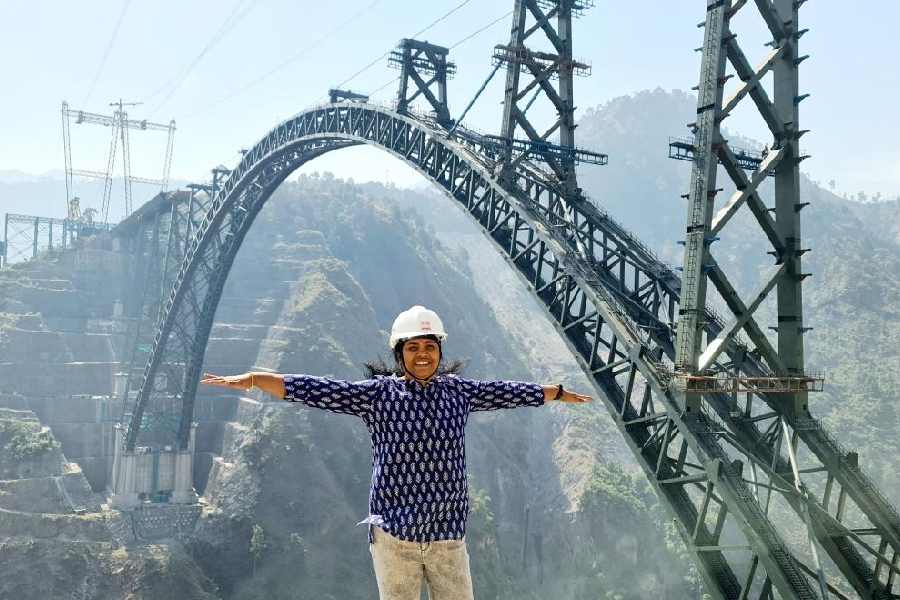 |
| Commuters walk along railway tracks as train service stopped after the tracks were inundated after a heavy shower in 2007 |
With the early onset of monsoons this year and the Alipore met office predicting a prolonged wet spell, people living along the rail tracks and the rail commuters are bracing themselves for some major waterlogging. Both the civic and railway authorities are ducking responsibilities of clearing and desilting drains and catchment areas. In 2007, the rail tracks near the Tikiapara car shed went under water after continuous rain for three days caused by a deep depression in the Bay of Bengal. Both long and short distance trains had to be stopped near the Tikiapara car shed and thousands of passengers had to reach Howrah Station walking along the tracks risking their lives.
“I still remember how I reached Howrah Station walking along the tracks. It was risky because the tracks were not visible under water in most of the places. Old women and children, all passengers from long-distance trains, had to lug their heavy baggage wading through the water,” said Pradip Sengupta, a resident of Bally. For more than a week, thousands of passengers suffered as the rail tracks remained submerged.
A similar spectre stares in the face yet again. Senior rail officers of Eastern Railway admitted that there was every chance of the rail tracks getting inundated this year also since the monsoon set in nearly two weeks before schedule and it has been raining quite regularly. Though the railway officials expressed concern and claimed to be working closely with the Howrah Municipal Corporation (HMC) to keep the rail tracks free of waterlogging, lack of coordination between the Eastern Railway authorities and the civic body was clear.
“We are constantly keeping in touch with the HMC. The civic body informed us that they have already cleared the drains through which accumulated water from rail tracks can drain out. On our part, we have kept our portable pumps ready for pumping out accumulated water,” said R.N. Mahapatra, chief public relation officer, Eastern Railway.
However, the civic authorities were complaining. “We, on our part, have desilted the drains much before the onset of monsoons so that the rail tracks are not flooded during the rains, but the railway authorities are not doing anything. The Eastern Railway sent their representatives to our meetings but they did not act according to our suggestions,” said Debasish Ghosh, member of mayor-in-council, HMC.
Ghosh alleged that the rail authorities are not interested in working jointly with the civic body to prevent inundation. They are only willing to pump out the accumulated water from the areas but are not bothered that the pumped out water can inundate fresh areas. He said that two drains, one along Dasarath Ghosh Lane and another along Fakir Bagan Lane that carry the accumulated water from the rail area to the Rani Jheel were not wide enough to carry such huge volume of water. “Even after repeated requests, the railway authorities have not desilted the Rani Jheel and cleared the waterbody of the heavy growth of hyacinth.
 |
| Water drained out of railway tracks accumulates in the adjoining areas causing waterlogging |
This causes obstruction in the flow of water and due to siltation in the Rani Jheel over the years, the water body is no longer able to hold a lot of water,” said Ghosh. He said that it was the responsibility of the railway authority to see that accumulated water drains out quickly and easily.
But the Eastern railway authorities are not willing to do anything other than draining out water from their area. “All over India, the local bodies along the rail tracks take the responsibility of draining out the water that accumulates in the railway area. Why should HMC be an exception,” asks Mahapatra.
The HMC officials, on their part, allege that a vast area of north Howrah gets flooded as the Eastern Railway pumps out water from their area. The worst effected areas are Dharmatala Road, Amloki Bagan, Tandel Bagan Rail Colony, Fakir Bagan Lane, Nando Ghosh Road, B. L. Roy Road, Tinkarinath Bose Lane, Sashibhusan Sarkar Lane, RPF barrack and GRP barracks.
At least five schools located in Fakir Bagan and Nanda Ghosh Road have to be closed during monsoon as the schools go under waist deep water. “Since the areas near the rail track are located in the low-lying areas, the water remains stagnant for weeks even after the rain stops,” said Umesh Rai, a resident of Kings Road. He said that HMC and Eastern Railway authorities should jointly work to stop such waterlogging. He alleged that the railway authorities are not even bothered when their employees living in the rail colonies suffer due to such waterlogging. After a High Court order, Eastern Railway started desilting Rani Jheel a few years back. But only part of the desiltation work is done every year. “Desiltation starts a few months before the onset of monsoon. The slush dug out from the waterbody is dumped on the bank but during monsoon, heavy rain washes the slush back into the waterbody again. This is going on for years,” said an HMC engineer.










